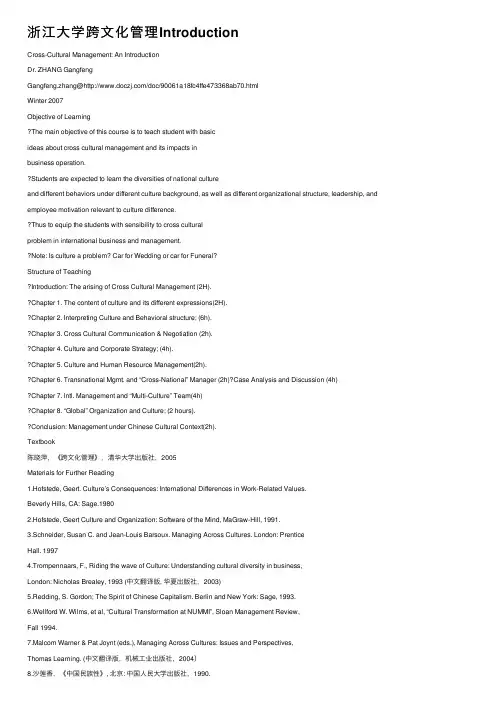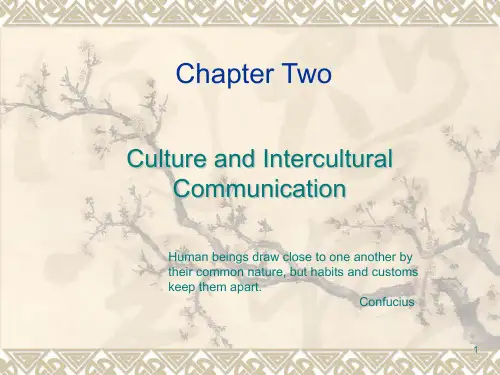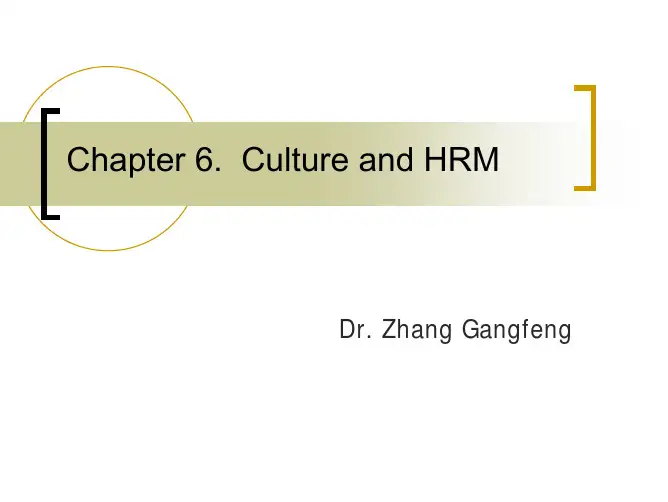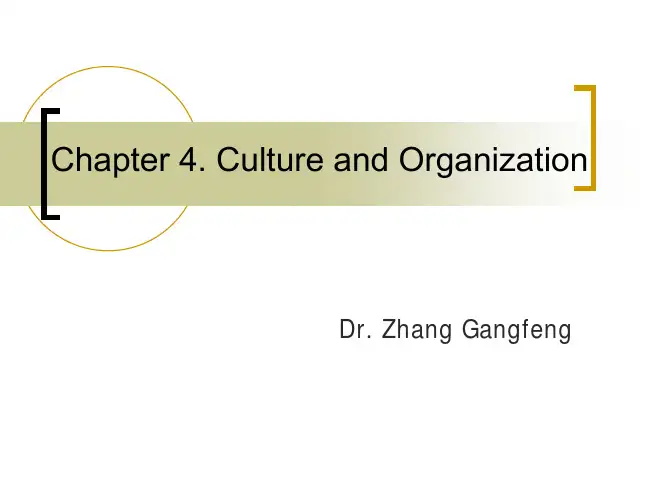浙江大学跨文化管理张刚峰老师课件 Chapter_5_Culture_and_Strategy
- 格式:pdf
- 大小:131.39 KB
- 文档页数:6



浙江⼤学跨⽂化管理IntroductionCross-Cultural Management: An IntroductionDr. ZHANG GangfengGangfeng.zhang@/doc/90061a18fc4ffe473368ab70.htmlWinter 2007Objective of LearningThe main objective of this course is to teach student with basicideas about cross cultural management and its impacts inbusiness operation.Students are expected to learn the diversities of national cultureand different behaviors under different culture background, as well as different organizational structure, leadership, and employee motivation relevant to culture difference.Thus to equip the students with sensibility to cross culturalproblem in international business and management.Note: Is culture a problem Car for Wedding or car for FuneralStructure of TeachingIntroduction: The arising of Cross Cultural Management (2H).Chapter 1. The content of culture and its different expressions(2H).Chapter 2. Interpreting Culture and Behavioral structure; (6h).Chapter 3. Cross Cultural Communication & Negotiation (2h).Chapter 4. Culture and Corporate Strategy; (4h).Chapter 5. Culture and Human Resource Management(2h).Chapter 6. Transnational Mgmt. and “Cross-National” Manager (2h)Case Analysis and Discussion (4h)Chapter 7. Intl. Management and “Multi-Culture” Team(4h)Chapter 8. “Global” Organization and Culture; (2 hours).Conclusion: Management under Chinese Cultural Context(2h).Textbook陈晓萍,《跨⽂化管理》,清华⼤学出版社,2005Materials for Further Reading1.Hofstede, Geert. Culture’s Consequences: International Differences in Work-Related Values.Beverly Hills, CA: Sage.19802.Hofstede, Geert Culture and Organization: Software of the Mind, MaGraw-Hill, 1991.3.Schneider, Susan C. and Jean-Louis Barsoux. Managing Across Cultures. London: PrenticeHall. 19974.Trompennaars, F., Riding the wave of Culture: Understanding cultural diversity in business,London: Nicholas Brealey, 1993 (中⽂翻译版, 华夏出版社,2003)5.Redding, S. Gordon; The Spirit of Chinese Capitalism. Berlin and New York: Sage, 1993.6.Wellford W. Wilms, et al, “Cultural Transformation at NUMMI”, Sloan Management Review,Fall 1994.7.Malcom Warner & Pat Joynt (eds.), Managing Across Cultures: Issues and Perspectives,Thomas Learning. (中⽂翻译版,机械⼯业出版社,2004)8.沙莲⾹,《中国民族性》, 北京: 中国⼈民⼤学出版社,1990.9.李泽厚, 《中国古代思想史》,北京: ⼈民出版社,198510.孙隆基,《中国⽂化的深层结构》,⼴西师范⼤学出版社,200411.范徵,《跨⽂化管理:全球化于地⽅化的平衡》;上海外语教育出版社,2004Evaluation of the studyThe evaluation components for this course are asfollows:Case Assignment & discussion 20%Individual Participation20%Final Exam60%Total100%The rising ofCross Cultural managementDiscovery of Culture-based ManagementUntil the 1970s it was generally assumed thatmanagement was much the same around the world.This idea may be supported by the following argument:Management for profit and …one best way?Company will be constrained in their pursuit of efficiency and cost saving.Technology is the same worldwide and it have s homogenizing effect.The effect of OB as a subject is to make us aware of the universal similarity of human behavior in organization.The idea of homogeneity of management got a furtherboost from Convergence (趋同)Theory.The essence of convergence theory is thatindustrialization, having its own laws and dynamics, will naturally transcend (超越)national differences.Discovery of Cultural difference in managementIn 1977, Israeli professor in INSEAD Theodore Weinshallcompiled a set of readings under the title of “Culture andManagement” .In 1979, Philip Harris & Robert Moran published “ManagingCultural Differences: Leadership strategies for a New World of Business”.The success of Japanese companies caused awareness ofmanagerial differences in different countries.When MBO (Management by Objective) was introduced intoEurope, it encountered huge problems in Germany and France.LEST’s salary hierarchy studyLEST(Laboratoire d?Economie et de Sociologie du Travail)did two studies on salary hierarchy inFrance and West Germany, It was found that the gap between the highest paid and the lowest paid was bigger in France than in Germany. LEST’s further studyFrench GermanMany levels in the hierarchy Emphasis on managementStrong demarcation(区分)lines between grades of worker High proportion of production workersQualifications rule OK Vorsprung durch technik(advantage through technique)France GermanyEducation (elite)Training (professional) Hierarchy FunctionBureaucracy Skills Administration…Technik?André Laurent’s Study in 1980sPositive Responses …Most organizationswould be better off ifconflict could beeliminated for ever.?…It is important for a manager to haveat hand precise answers to most ofthe questions that his subordinatesmay raise about their work.?Sweden4%10% USA6%18% UK13%27% Germany16%46% Holland17%17% Switzerland18%38% Denmark19%23% France24%53% Belgium27%44% Italy41%66%Age of globalization calls for Cross culturalmanagementSince 1980s, cross border investment has beenincreased dramatically. More and more managersencounter difficulty in operating abroad successfully.Therefore people come to realize the importance ofcross cultural management.Since the middle of 1980s, Since the mid-80s thegrowth rate of FDI has been around four times higherthan that of global GNP growth. In 1973, global FDI flow is about 21.5 billion USD, but it reached to 735 billion in 2001.With the popularity of international trade, cross culturalcommunication or negotiation also becomes important, or even critical to the success of business operation.Why we need to study Cross Cultural Management?The importance of Cross CulturalManagementInternational Trade and FDILatest Development of world tradeGlobal gross domestic production (GDP) growth accelerated to3.7% in 2006, the second best performance since 2000.The dollar value of world merchandise exports increased by 15%to $11.76 trillion in 2006. Commercial services exports were up by an estimated 11% and reached $2.71 trillion in 2006. Developing countries share of world merchandise exportsreached an all time record of 36%. The 0.9% share for least-developed countries was also a record, the highest level since 1980,Chinas trade growth continued to outstrip other major traders.China?s merchandise exports grew by 27%. In the second half of 2006, its merchandise exports started to exceed those of the United States, but for the whole year US exports still exceeded those of China.Global Capital FlowsPortfolio and other short-term capital flows now total more than 2trillion US dollars, approximately three times those of the 1980s.The daily turnover in foreign exchange markets has increased,from an average of 10-20 bln USD in 1970s, to about 200 billion in the mid-80s, to well over 1.2 trillion in 1996, and 1.5 trillion in 1998. International bank lending grew from 265 billion USD in 1975 to4.2 trillion USD in 1994.Global FDI flows remained almost flat in 2003, at the five-yearlow of approximately $600 billion recorded in 2002.Foreign Direct InvestmentIn 1973, global FDI was 21.5 billion US dollars, and in 1997 itexpanded to almost 400 billion US dollars, which represents an annual average growth rate of almost 13%.FDI stocks jumped from 165 billion US dollars at the end of1973 to 3205 billion US dollars in 1996 (WTO 1998; UNDP 1999).Since the mid-80s the growth rate of FDI has been aroundfour times higher than that of global GNP growth.FDI flows collapsed after the burst of the IT bubble and thestock market crashes in 2001. Due to the steep fall of FDIflows, the ratio of FDI flows to gross fixed investmentdecreased to 11%, after a fivefold increase between the early 1990s(4%) and 2000(20%). 1987-2003 Global FDI Flow(unit:billion USD)Year1987-921993199419951996199719982000200120022003 YearAverageGlobal173.52192353293594646441492735600600 FDI。







